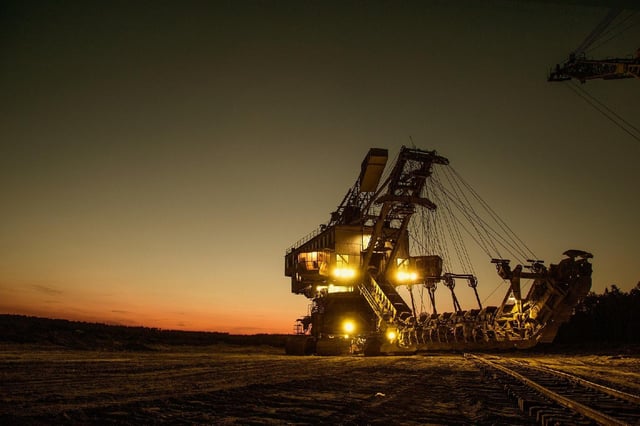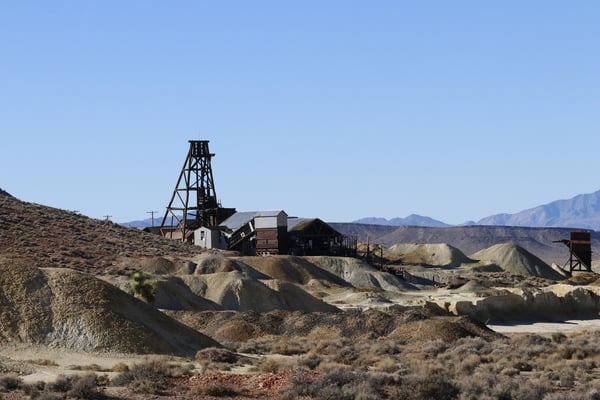Acid mine drainage: we’ve all heard of it, and its negative reputation. But what if we told you that it’s not all bad? What if this environmental pollutant was recovered and transformed into a profit-turning resource? [Bejan & Bunce, 2015] There are varying methods of dealing with acid mine drainage (AMD), but only some of them are economically viable and effective long-term. This blog post is going to dive into some of the solutions for the treatment of AMD, and how emew technology provides one of the most promising alternatives, specifically for copper recovery from acid mine drainage.
What is acid mine drainage (AMD)?
Acid mine drainage (AMD) is a very acidic solution that is high in concentrations of metals such as copper, arsenic, aluminum, zinc, and iron [Natarajan, 2018]. For more information about acid mist, refer to our blog post. AMD, which is also known as acid rock draining (ARD), forms under natural conditions when sulfide-bearing material found in the earth’s crust (or mine slag) is exposed to oxygen and water [Akcil & Koldas, 2006]. When these minerals are oxidized they create a solution that is highly acidic (pH 2.5 to 6.0) and contains metallic ions [Natarajan, 2018; Vallero, 2006]. This process can be sped up by the presence of naturally occurring bacteria: acidophilic microorganisms (thriving under highly acidic conditions, catalyzing the oxidation of sulphides) [Akcil & Koldas, 2006].

The most common sources of AMD are mine rock dumps, tailings ponds, underground and open pit mines, treatment sludge ponds [Akcil & Koldas, 2006]. AMD can contaminate surface water, groundwater, and soils, which is why mines need to be managed to ensure they are not creating AMD.
To download fill the form below
How can acid mine drainage be managed?
The environmental impact of acid mine drainage can be minimized through control methods, broken into primary, secondary, and tertiary levels [Akcil & Koldas, 2006]:
- Primary control: prevention of the acid-generating process
- Secondary control: acid drainage migration prevention measures
- Tertiary control: collection and treatment of effluent
Primary and Secondary Treatment Methods:
Prevention techniques include management of rock wastes and tailings, such as mine backfill by mixing mine tailings with a mixture of waste materials (soil, crushed aggregate, sand, or cement) in order to minimize acid formation [Kefeni, 2017]. Backfilling and sealing the mine prevents air from reaching the rocks, minimizing oxidation of the sulphide minerals. Above ground, dry cover and water cover are two methods used to create oxygen barriers over tailings; dry cover materials include low-sulphide content tailings, organic wastes, clay sub-soils, or other soils and neutralising materials.
Tertiary Treatment Methods:
Treatment of AMD can be divided into two categories: passive and active [Kefeni, 2017].
Passive Treatment
Passive treatment methods include biological treatment with constructed wetlands, chemical treatment with limestone drains, or use of a permeable reactive barrier [Kefeni, 2017]. Passive treatment is most effective for abandoned mines, not those with continuous flow of AMD water. Passive methods are only effective for low concentrations of metals; active methods should be used for higher concentrations.
Active Treatment
Active treatment methods include metal precipitation or adsorption through the addition of alkaline chemicals, or the use of membrane technology [Kefeni, 2017]. Common methods include neutralisation using alkaline chemicals such as calcium hydroxide (Ca(OH)2) or limestone (CaCO3), precipitating metal hydroxides and sulphate as a gypsum sludge (CaSO4.2H2O).
Ca(OH)2 + MSO4 + 2H2O -> CaSO4.2H2O + M(OH)2
Another method is using the alkaline barium calcium desalination process, reducing metals and sulphate below toxic levels. In this process, AMD is neutralized for metal and sulphate removal, followed by sludge processing, but this process is new, and has yet to prove if the water recovered is of drinking water quality [Kefeni, 2017].
One solution available that provides the best recovery of the valuable metals and sulphate held in AMD is electrowinning. Recovery and reuse of these chemicals can assist in sustainable mining operations, and reduction of environmental pollution. There are many valuable metals that can be recovered from AMD, such as copper, zinc, nickel, and cobalt, all which can be recovered using electrowinning. Sulphuric acid can also be recovered using electrowinning technology combined with ion exchange (IX). The IX process allows for purification and concentration of targeted ions from the AMD, prior to electrowinning. Pairing of IX and electrowinning is a service offered by emew, allowing for better recovery of metals and acids in low concentration AMD streams.
Copper Recovery from AMD
Copper can be found naturally as sulfide ore or oxide ore, with the most common being the chalcopyrite (CuFeS2) [Da Silva, 2019]. Because copper and iron are found together in this mineral, when mined, they both can be found in high concentrations of AMD. This high concentration of copper poses risks to aquatic and terrestrial ecosystems, and to human health [Larsson, 2018; USEPA, 2014].
Copper can easily be recovered from AMD using electrowinning. Electrowinning for copper recovery from AMD has been used in Berkeley Pitt in Butte, Montana and the Penn Mine in Camanche Reservoir in California [Bejan & Bunce, 2015]. When low concentrations of copper exist, use of a porous cathode can enhance copper recovery, another possible advantage of emew, using proprietary 3D cathode technology.
How electrowinning solves the acid mine drainage problem
There are four main environmental concerns with acid mine drainage, which also complicate its treatment [Bejan & Bunce, 2015]:
- High acidity, low pH
- High iron concentrations
- High sulphate concentrations
- Variable concentrations of other (possibly toxic) metals
The benefit of emew technology is that it can overcome almost all of these problems. The innovative electrowinning technology offered by emew allows valuable metals such as copper, nickel and cobalt be recovered from low pH AMD waste-water as a stand alone equipment or in conjunction with other treatment methods including precipitation and ion exchange, depending upon the treatment objectives. Additionally, there is a concern of power access in remote mine locations; electrowinning cells typically run on DC power, there is the possibility of utilizing solar energy to power emew cells in these remote areas.
Where some may view acid mine drainage as a liability, or an environmental problem, it can be considered a valuable resource, if you have the right tools (like an emew cell). Recovery of both the metals and the sulphate in AMD can provide a significant economic offset to remediation, turning AMD from an environmental problem into a financial gain.
References
Akcil, A., & Koldas, S. (2006). Acid Mine Drainage (AMD): causes, treatment and case studies. Journal Of Cleaner Production, 14(12-13), 1139-1145. doi: 10.1016/j.jclepro.2004.09.006
Bejan, D., & Bunce, N.J. (2015). Acid mine drainage: electrochemical approaches to prevention and remediation of acidity and toxic metals. Journal of Applied Electrochemistry, 45, 1239–1254 doi: 10.1007/s10800-015-0884-2
Da Silva, O. (2019). Types of Copper Deposits in the World. Retrieved 23 April 2020, from https://investingnews.com/daily/resource-investing/base-metals-investing/copper-investing/types-copper-deposits-world/
Kefeni, K., Msagati, T., & Mamba, B. (2017). Acid mine drainage: Prevention, treatment options, and resource recovery: A review. Journal Of Cleaner Production, 151, 475-493. doi: 10.1016/j.jclepro.2017.03.082
Larsson, M., Nosrati, A., Kaur, S., Wagner, J., Baus, U., & Nydén, M. (2018). Copper removal from acid mine drainage-polluted water using glutaraldehyde-polyethyleneimine modified diatomaceous earth particles. Heliyon, 4(2), e00520. doi: 10.1016/j.heliyon.2018.e00520
Natarajan, K. (2018). Microbial Aspects of Acid Mine Drainage—Mining Environmental Pollution and Control. Biotechnology Of Metals, 395-432. doi: 10.1016/b978-0-12-804022-5.00013-x
U.S. Environmental Protection Agency (USEPA). (2014). An Assessment of Potential Mining Impacts on Salmon Ecosystems of Bristol Bay, Alaska [Ebook] (pp. 4-3). United States Environmental Protection Agency (USEPA). Retrieved from https://www.epa.gov/sites/production/files/2015-05/documents/bristol_bay_assessment_final_2014_vol1.pdf
Vallero, D. (2006). Dropping Acid and Heavy Metal Reactions. Paradigms Lost, 339-365. doi: 10.1016/b978-075067888-9/50011-9






